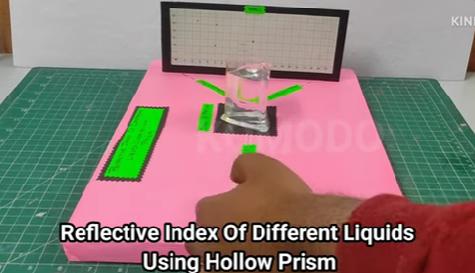
Creating a Reflective Index of Different liquid using hollow prism Working model Step by Step Making.
Materials Required
| 1. Laser Light | 2. O.H.P Sheet |
| 3. Quick Fix Glue | 4. Card Board |
| 5. Graph Paper | 6. Colour Paper |
| 7. Thermacol | 8. Glue |
Explore the science behind how liquids like water, oil, and alcohol interact with light. This fascinating experiment combines physics and creativity, making it perfect for students. Boost your knowledge with Komodo Craft!
Topics Included
Table of Contents
Steps to Make the Working Model
Step 1: Set Up the Hollow Prism
- Place the hollow prism on a flat surface or a stand.
- use clear plastic sheets to form a triangular shape.
Step 2: Fill the Prism with Liquid
- Pour water into the hollow prism.
Step 3: Set Up the Laser Light
- Place the laser pointer on a stand.
- Aim the laser beam at one face of the prism.
- Adjust the angle of the laser beam so it enters the prism at a slight tilt.
Step 4: Setup O.H.P Sheet
- Place the O.H.P Sheet and a Graph Paper of paper on the other side of the prism to observe the refracted light.
- Mark the spot where the laser beam exits the prism.
Step 5: Measure the Angles
- Use a protractor to measure:
- Angle of incidence: The angle at which the laser beam enters the prism.
- Angle of refraction: The angle at which the beam exits the prism.
- Write these measurements down for each liquid.
Related – Wheat Stone Bridge Working Model
Refractive Index of Different Liquids Using a Hollow Prism
To concentrate on the refractive index of liquids, researchers utilize special devices like prisms. Be that as it may, did you realize we can utilize a hollow prism to do this trial? We should make a plunge and learn all about it!
What Is a Refractive Index?
The refractive index (n) measures how much light dials back and twists when it moves starting with one material then onto the next. For example:
Light travels faster in air however dials back when it enters water or oil.
This dialing back causes the light to twist, and the amount of bowing relies upon the refractive index of the fluid.
Why Use a Hollow Prism?
A hollow prism is a special prism that is vacant inside. It is made of transparent materials like glass or plastic and can be loaded up with any liquid we want to study. Here’s why it’s useful:
Versatility: You can fill the prism with various liquids, like water, oil, or sugar solution, to concentrate on their refractive record.
Easy Observation: The hollow prism lets light pass through the liquid, making it easy to perceive how the light curves.
Reusable: You can discharge and top off the prism on numerous occasions with various liquids, making it a savvy instrument.
How Does a Prism Work?
A prism works by bending or refracting light. When a ray of light enters the prism, it dials back and twists at the surface where air and liquid meet. Inside the prism, the light travels through the liquid and twists again when it exits.
The amount of bending depends on:
The angle of the prism.
The refractive record of the liquid inside.
By concentrating on this bending, we can calculate the refractive record of the liquid.
What Happens When Light Passes Through a Liquid?
When light passes through a liquid inside the hollow prism, it behaves with a certain goal in mind:
Refraction at the First Surface: As the light enters the prism, it dials back and curves towards the normal line (an imaginary line perpendicular to the surface).
Travel Through the Liquid: Inside the prism, the light moves at a more slow speed, contingent upon the refractive file of the liquid.
Refraction at the Second Surface: When the light leaves the prism, it twists again, this time away from the normal line.
This twofold bending creates an angular deviation that assists us with measuring the refractive file.
Thanks for Reading the Article, please feel free to comment us or contact us on shakunkumar55@gmail.com
Visit our Youtube Channel for model making videos and projects content.